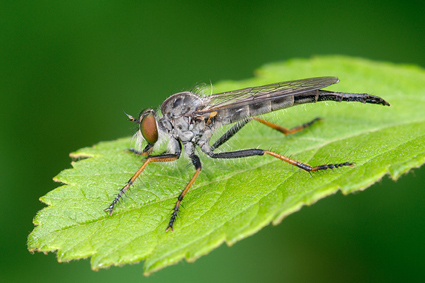Asilinae sensu Dikow 2009a

Neoitamus flavofemoratus , image © Michael Thomas.
Asilinae
– macrosetae on lateral margin of frons present (49)
– prosternum and proepisternum separated and prosternum triangular and pointed dorsally (74)
– female S8 proximally platelike and distally hypogynial valves forming a keel (170)
– male gonocoxites entirely free (202)
The strict consensus topology in figure 119 (Dikow 2009a) illustrates the unresolved relationships among Asilinae genera including the Apocleinae sensu previous authors. This highlights the fact that the characters employed by Dikow (2009) cannot group the morphologically very similar species into less inclusive taxa. The monophyly of Asilinae is, however, corroborated and has never been questioned before by previous authors.
Apocleini: Apoclea, Megaphorus, Philodicus, Promachus
– facial swelling extending over lower facial half (4)
– postmetacoxal bridge partly developed laterally, but membraneous medially (102)
– stump vein on R4 present and reaching base of R2+3 (146)
– female with median sclerite at posterior end of furca (183)
– male gonocoxal apodeme long and extending well into abdominal segment 8 (204)
The Apocleini is the remnant of the Apocleinae sensu Artigas & Papavero (1988) and Geller-Grimm (2004). However, Artigas & Papavero (1997) combined the Asilinae and Apocleinae and the placement of Apocleini within Asilinae is corroborated here.
Asilini: Asilus
– maxillary stipites fused entirely medially (14)
– female T2–3 without marginal setae (160, 161)
– male T2–5 without marginal setae (186, 187, 188, 189)
In the Dikow (2009) analysis, only the single genus Asilus is placed in the Asilini as Satanas does not group with Asilus.
Lycomyini: Lycomya
– facial swelling extending over lower half of face (4)
– prementum of labium dorsoventrally flattened (18)
– stylus composed of two elements (58)
– anatergal setae present (82)
– postmetacoxal bridge partly developed laterally, but membraneous medially (102)
– setiform empodium reduced in length (127)
– microtrichia on posterior margin of wing arranged in two divergent planes (141)
– T2 longer than wide, but less than twice as long (153)
– male subepandrial sclerite with protuberances medially (208)
Lycomyini has been described for the single Chilean genus Lycomya by Lynch Arribalzaga (1882).
Machimini: Machimus
This taxon is apparently non-monophyletic as the two included species of Machimus do not form a clade. In light of the unresolved relationships within the Asilinae, no comments on the monophyly of the genus or the taxon can be made at this stage.
Neomochtherini: Afromochtherus, Neomochtherus
– setae on posterior basalare absent (81)
– female T8 with posteriorly directed setae (168)
Neomochtherini has been described by Lehr (1996) to also include Dysmachus, but this genus is part of the Asilinae genera that cannot be placed in any higher-level taxon.
Philonicini: Philonicus
– microtrichia on posterior margin of wing arranged in two divergent planes (141)
– female T5 without any marginal setae (163)
– female with spurs on cerci (174)
Philonicini has been described by Lehr (1996) based on the single genus Philonicus.
Genera not placed within above tribal taxa:
